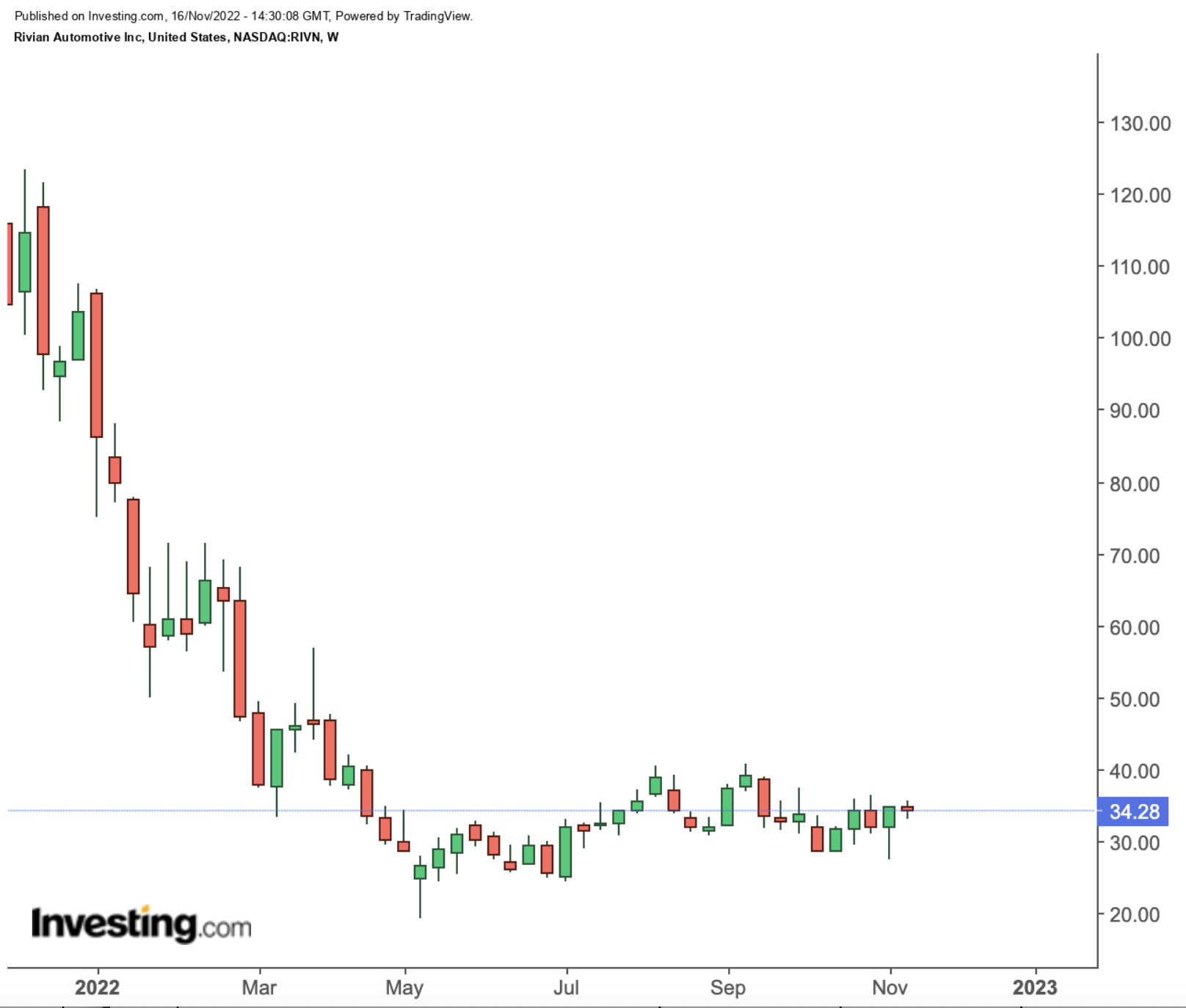- A year after its initial public offering, RIVN stock has disappointed
- But, for the most part, the Rivian business is on track
- Cyclical, macroeconomic risks might deter most investors, while the rest should consider RIVN
On Nov. 10, 2021, Rivian Automotive Inc (NASDAQ:RIVN) went public. In the largest initial public offering of the year, Rivian raised $12 billion. RIVN stock was priced at $78, and closed its first day above $100.
On Tuesday, just over a year later, RIVN closed at $35.15, down 65% from that first-day close. That plunge would seem to suggest Rivian has disappointed investors.

Source: Investing.com
But, in fact, that doesn’t actually appear to be the case. To this point, Rivian has mostly delivered on its promises.
Rather, what’s hit RIVN stock is a broad sell-off in growth stocks, and rising risks outside its doors. Neither of those short-term effects can, or should, be ignored. However, investors willing to take the long view, and take on those near-term risks, should at least consider RIVN after the sell-off.
Why Nothing Has Changed for Rivian
When Rivian went public a year ago, the mid-term outlook was clear. Rivian was going to lose money for some time to come, as it ramped production of its R1 consumer platform and its EDV (Electric Delivery Van) commercial offering.
Major investor Amazon.com (NASDAQ:AMZN) was going to soak up the majority of EDV production. The consumer backlog of 55,400 pre-orders (as of Oct. 31 of last year) would keep deliveries intact until, roughly, the end of 2023. From there, Rivian would ramp up sales, expand its product line and keep heading in the direction of profitability.
That story remains almost completely intact. Just last week, Amazon itself touted its fleet of Rivian vehicles, and reaffirmed a goal of having 100,000 vehicles on the road by the end of the decade. The number of pre-orders has more than doubled through the first three quarters of 2022. One analyst did the math and noted that order rates actually have accelerated.
Full-year guidance for production of 25,000 vehicles was issued earlier this year — and reiterated after Q3. Rivian has had some small missteps, including a recall last month, but nothing unsurprising for a new manufacturer.
New models still appear to be on the horizon. Production capacity is increasing. Rivian is doing what it said it was going to do. Many rivals — particularly on the commercial side — cannot say the same.
Rivian even added a partnership with Mercedes-Benz to tackle the European market. And its vehicles are getting rave reviews.
This still looks like a company on track to gain substantial market share in electric vehicles, both in trucks and sport-utility vehicles as well as on the commercial side. That’s precisely the outlook investors saw when they bid RIVN up to a valuation well past $100 billion last year.
Yet So Much Has Changed
Of course, that $100 billion-plus valuation is a key reason why RIVN has lost more than two-thirds of its value from its peak. That valuation was well past those of Ford (NYSE:F) and General Motors (NYSE:GM); a good deal of success was priced in, and then some.
Assuming that RIVN is a buy now because it’s ~70% cheaper in turn assumes that the previous price was “correct.” That’s far from guaranteed to be the case. Given how broad and steep the sell-off in early-stage growth stocks has been, and the low float of RIVN stock immediately after the IPO, it certainly seems like optimism simply ran too far.
The decline to $35 may, thus, be a needed correction rather than a buying opportunity. Of course, given how much work Rivian still has to do, reasonable investors can have exceptionally divergent views of what the long-term valuation should look like.
That aside, there’s the macroeconomic problem. Rivian already has dealt with the impact of inflation, having to walk back a 20% price increase in March. A U.S. recession would add to inflationary pressures, and potentially dim the company’s mid-term growth. It could also dim the risk-taking appetite needed to keep the stock afloat.
These near-term risks are real. And they can have a long-term impact. Established rivals like Ford and GM may be better able to manage through a volatile environment, given stronger balance sheets, longer customer relationships and greater scale.
All that said, there’s still an attractive story here. A leader in worldwide EV manufacturing is going to have a valuation well above Rivian’s current $32-billion market capitalization. The two key questions are whether Rivian will become a leader — and how much higher that valuation can get. So far, the company has delivered on its promises, but there are years of work ahead.
Disclaimer: As of this writing, Vince Martin has no positions in any securities mentioned.
Which stock should you buy in your very next trade?
AI computing powers are changing the stock market. Investing.com's ProPicks AI includes 6 winning stock portfolios chosen by our advanced AI. In 2024 alone, ProPicks AI identified 2 stocks that surged over 150%, 4 additional stocks that leaped over 30%, and 3 more that climbed over 25%. Which stock will be the next to soar?
Unlock ProPicks AI
